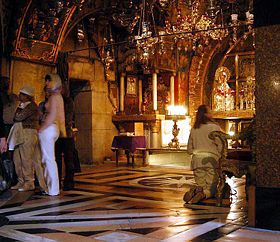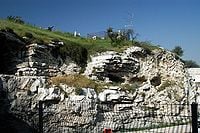Calvary
- "Golgotha" redirects here. For other uses, see Golgotha (disambiguation). For other uses of the term "Calvary", see Calvary (disambiguation).
- Not to be confused with cavalry (horse or armored troops).
Calvary (Golgotha) is the English-language name given to the hill on which Jesus was crucified. The hill is described as outside Jerusalem, but its location is not certain. Calvariae Locus in Latin, Κρανιου Τοπος (Kraniou Topos) in Greek and Gûlgaltâ in Aramaic all mean 'place of [the] skull', referring to a hill or plateau containing a pile of skulls or to a geographic feature resembling a skull.
Romans typically crucified along roadways. The Bible tells us that many “passed by.” Matthew 27:39 The word “Calvary” comes into the English Bible only from the King James Version in Luke 23:33. The translators imported this word from the Latin Vulgate.
Calvary is mentioned in all four of the accounts of Jesus' crucifixion in the Christian canonical Gospels:
- Matthew 27:33
- And they came to a place called Golgotha, which is called the Place of the Skull.
- Mark 15:22
- And they took him up to the place Golgotha, which is translated Place of the Skull.
- Luke 23:33
- Then they came up to the place called Skull.
- John 19:17
- And carrying his cross by himself, he went out to the so-called Place of the Skull, which is called in 'Hebrew' Golgotha.
Luke's Gospel does not give the local, Aramaic name, Golgotha. John's Gospel somewhat misleadingly labels the name as 'Hebrew', indicating the 'language of the Hebrews', which was Aramaic at that time.
The New Testament describes Calvary as close to Jerusalem (John 19:20), and outside of its walls (Hebrews 13:12). This is in accordance with Jewish tradition, as Jesus was also buried near to the place of his execution.
Roman emperor Constantine the Great built the Church of the Holy Sepulchre on what was thought to be the sepulchre of Jesus in 326 - 335, nearby the location of Calvary. According to Christian legend, the Tomb of Jesus and the True Cross were discovered by the Empress Helena, mother of Constantine in 325. The Church of the Holy Sepulchre is now within Jerusalem's Old City Walls, but it was beyond them at the time in question. The Jerusalem city walls were expanded by Herod Agrippa in 41-44 and only then enclosed the site of the Church of the Holy Sepulchre. Professor Sir Henry Chadwick (Dean Emeritus of Christ Church Oxford University) comments: "Hadrian's builders replanned the old city, incidentally confirming the bringing of the hill of Golgotha inside a new town wall (a fact implicit in a Good Friday sermon 'On the Pascha' by Melito bishop of Sardis about thirty years later). On this site, already venerated by Christians, Hadrian erected a shrine to Aphrodite (Chadwick, H., The Church in ancient Society. From Galilee to Gregory the Great. Oxford: Oxford University Press. 2003:21). Inside the church is a pile of rock about 5 m high, believed to be what now remains visible of Calvary. During restoration works and excavations inside the today's Church of the Holy Sepulchre in the years 1973-1978 it was found out that this place Calvary originally concerned with a quarry, in which white "Meleke limestone" was struck. A little hill could possibly have looked from the city like a skull. In 1986 a ring was found of 11.50 cm diameter, struck into the stone, which could have given to a wood trunk of up to 2.50 meters height. The church is accepted as the Tomb of Jesus by most historians and the little rock nowadays inside the present church as the location of Calvary. Pilgrim of Bordeaux is writing in 333: "There, at present, by the command of the Emperor Constantine, has been built a basilica, that is to say, a church of wondrous beauty. On the left hand is the "little" hill of Golgotha where the Lord was crucified. About a stone's throw from thence is a vault (crypta) wherein his body was laid, and rose again on the third day. (Latin original: ... est monticulus golgotha, ubi dominus crucifixus est.), pages 593, 594)." See also: Eyewitness-reports about the location of Calvary: Pilgrim of Bordeaux (in 333), Eusebius (338), bishop Cyrillus (347), pilgrim Egeria (383), bishop Eucherius of Lyon (440), Breviarius de Hierosolyma (530), in German. Professor Dan Bahat, one of Israel's leading archaeologists and a senior lecturer at the Land of Israel Studies at Bar-Ilan University in Tel Aviv, comments in 2007: "Six graves from the first century were found on the area of the Church of the Holy Sepulchre. That means, this place laid here outside of the city, without any doubt, and is the possible place for the tomb of Jesus."
Alternative Location of Calvary
After time spent in Palestine in 1882-83, Charles George Gordon suggested a different location for Calvary since it was not then known that the location of the Church of the Holy Sepulchre was actually outside of the city walls at the time of the crucifixion. The Garden Tomb is to the north of the Holy Sepulchre, located outside of the modern Damascus Gate], in a place of burial certainly in the Byzantine period. The Garden has an earthen cliff that contains two large sunken holes that people say to be the eyes of the skull. This might be linked to an ancient Christian tradition according to which the skull of Adam is buried at Golgotha.
Other uses of the name
The name Calvary often refers to sculptures or pictures representing the scene of the crucifixion of Jesus, or a small wayside shrine incorporating such a picture. It also can be used to describe larger, more monument-like constructions, essentially artificial hills often built by devotees.
Churches in various Christian denominations have been named Calvary. The name is also sometimes given to cemeteries, especially those associated with the Roman Catholic Church.
Two Catholic religious orders have been dedicated to Mount Calvary.
ReferencesISBN links support NWE through referral fees
- Bailey, Alice A. "From Bethlehem to Calvary." Lucis Publishing Company, 1975. ISBN 978-0853301073
- Barbet, Pierre. "A Doctor at Calvary: The Passion of Our Lord Jesus Christ As Described by a Surgeon." Roman Catholic Books, 1993. ISBN 978-0912141046
- Nicholson, William R. & Schaeffer, Daniel. "The Six Miracles of Calvary: Unveiling the Story of the Resurrection." Discovery House Publishers, 2002. ISBN 978-1572930728
External links
- Golgotha (Calvary) Hill-Photo: white stones, here visible right and left in the underground Retrieved April 18, 2007.
- The Hill of Calvary (Golgotha) shown in its original state Retrieved April 18, 2007.
- Location of Golgotha Retrieved April 18, 2007.
Credits
New World Encyclopedia writers and editors rewrote and completed the Wikipedia article in accordance with New World Encyclopedia standards. This article abides by terms of the Creative Commons CC-by-sa 3.0 License (CC-by-sa), which may be used and disseminated with proper attribution. Credit is due under the terms of this license that can reference both the New World Encyclopedia contributors and the selfless volunteer contributors of the Wikimedia Foundation. To cite this article click here for a list of acceptable citing formats.The history of earlier contributions by wikipedians is accessible to researchers here:
The history of this article since it was imported to New World Encyclopedia:
Note: Some restrictions may apply to use of individual images which are separately licensed.

